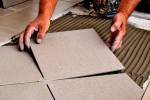Homemade template best tool for the job
Q: My kitchen cabinets need some sprucing up. They are cheap, with no raised panels and definitely no pizzazz. I was thinking of adding some door handles to give them a little flair, but I want to make sure the handles are perfectly aligned. What is the trick?
A: I've got a simple trick that will give your plain cabinets some character. You make a template so that each handle is positioned exactly in the same spot on each cabinet door. The handle will not only make a basic cabinet look more custom, it also will cut down on the wear and tear of the door.
Without handles, you are forced to open the door by touching it. You likely touch the door in the same spot each time and, over time, this creates a wear spot.
You can make a template out of almost anything rigid. I prefer using scrap wood such as medium-density fiberboard, but I know installers who use cardboard.
The handle will mount to the frame of the door, either the bottom or top, depending on whether they are base cabinets or wall-mounted cabinets.
The sizes and types of handles vary. At a home-improvement store, prices range from less than $1 per handle to around $5 per handle. You can really bust your budget by going to a specialty hardware retailer or shopping through a high-end catalog.
The handle will mount to the front of the cabinet door and will be held in place with either one or two screws through the back of the door. This means that you will have to drill one or two holes through the frame of the door. Do not install it through the flat panel of an inexpensive cabinet. This panel is typically too thin to support a handle.
Where to mount the handle is a matter of personal choice. Hold the handle up to the door and mark its position. Since most handles are installed somewhere near the corner of the door, measure in from both vertical and horizontal edges of the frame. Mark these distances down and grab the template material. Cut a piece of wood the width of the frame and about 9 inches long. To the back of this piece of wood, add two pieces of scrap wood to form a 90-degree corner on the back. Do this by turning the scrap wood on its edge and nailing it to the front piece to form the corner.
Place the template over a corner of the door. You should be able to hold the template against the door and have no side-to-side movement. Next, drill the holes in the template and you are ready to go.
Turn the template over so that the corner scraps face up. Use the measurements you took earlier and mark their locations from the inside of the scrap pieces. The inside of the scrap pieces represent the outside edges of the door. Drill holes just large enough for the handle screws to pass through, but not so large that the handle won't sit securely.
To use the template, hold it against each door, making sure that the corner pieces sit squarely against the edges of the door. The holes in the template will show you where to drill through the cabinet frame for the handles.
Bore through the frame from the front only. If you drill from the back, you risk a condition called tear out, which is when a drill bit pushes out the grain of the wood instead of cleanly cutting it. It makes for a very unsightly installation.
Once the holes are cut in the door frame, hold the handle in place and install the screw or screws through the back side. Tighten the screws snugly.
Michael D. Klimek is a licensed contractor and president of Pro Handyman Corp. Questions may be sent by e-mail to: questions@pro-handyman.com. Or, mail to: 2301 E. Sunset Road, Box 8053, Las Vegas, NV 89119. His Web address is: www.pro-handyman.com.























